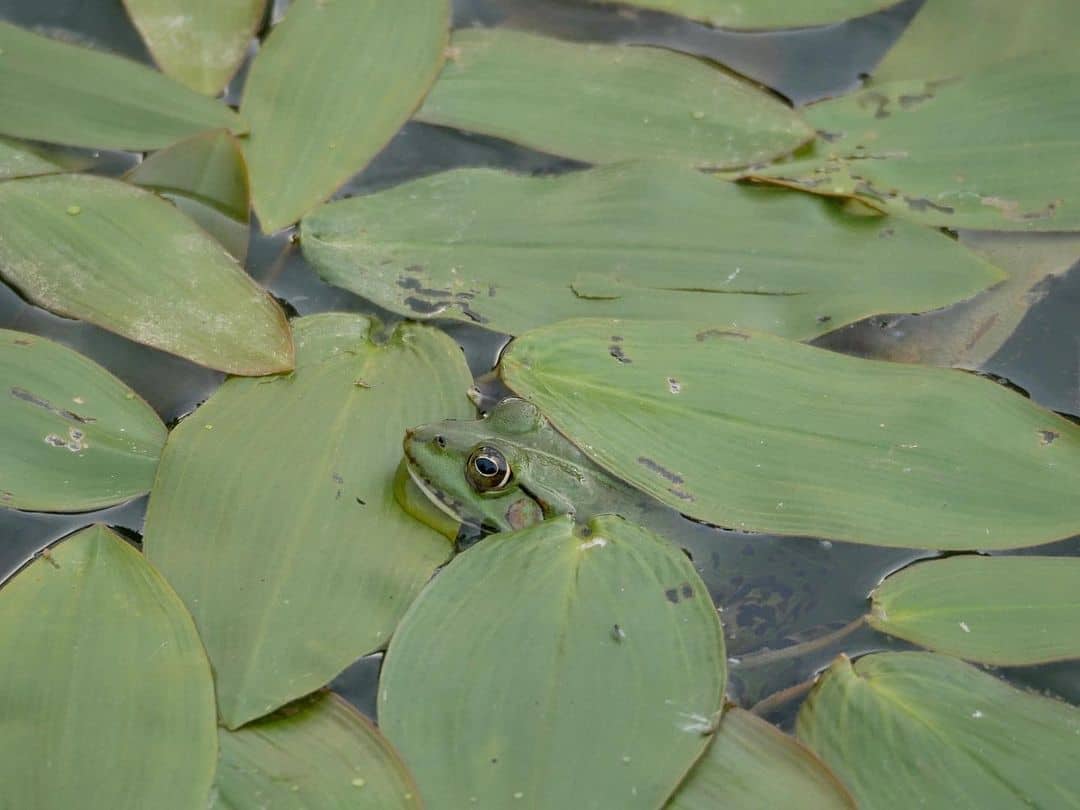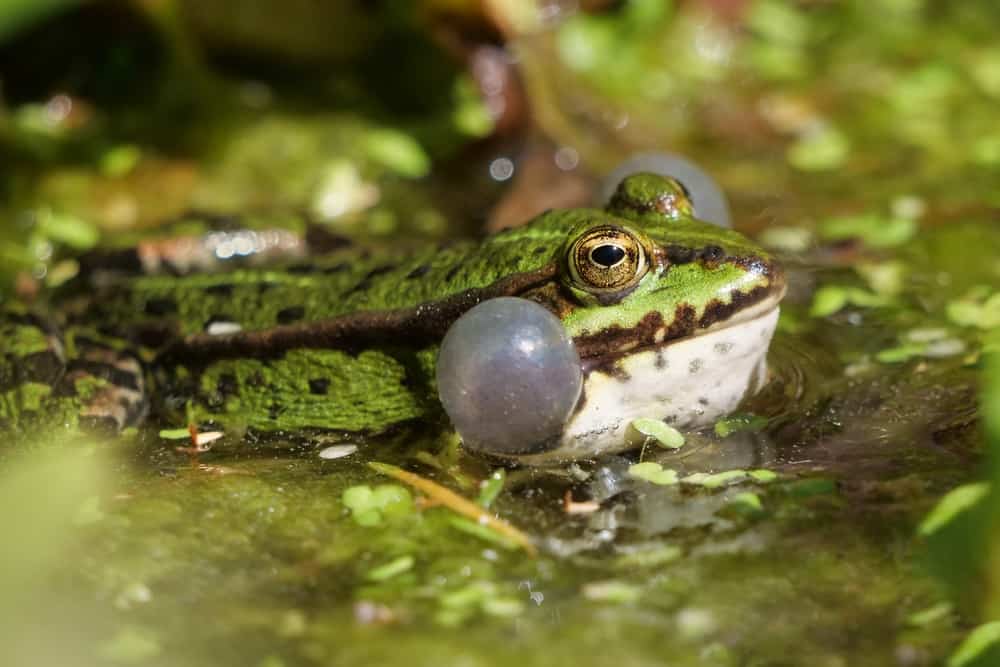We are all familiar with the “ribbit ribbit” sound, which we associate with frogs. However, do frogs make any other sounds besides this one? The answer is yes! You would be surprised to learn that frogs emit various other noises, and some of those do not sound very frog-like.
In addition, the sounds produced by these amphibians depend on particular species. In other words, different species of frogs have different vocalizations. For example, for some frogs, a mating call consists of honking, while others signal their mating by growling.
Furthermore, each of these sounds or noises has a specific purpose; they usually communicate with each other or warn against danger or predators.
Frogs and toads emit sounds like any other animal when attacked or chased by a predator. Before we dive into their types of calls, let’s check out why they call in the first place.
Why Do Frogs Call?

As mentioned, a frog’s most known or commonly heard sound is “ribbit ribbit,” or croaking. But what does it mean? This sound is actually a form of vocal advertisement or song made by male frogs looking for their potential partners.
Interestingly, males are the ones that usually produce sounds, although it is not rare to hear a female frog croaking or chirping. Male frogs make these sounds to advertise their location, defend their territory, and signal their mating readiness.
They also tend to make these noises when they find the right location for the female to lay eggs, near a lake or river, which are familiar places for frogs.
If you want to hear some of these sounds, the best period is in the spring or early Summer and during the night, considering that they are most active at night.
Similarly to owls, frogs are more often heard than seen and are mainly active at night. Furthermore, their sounds are so versatile and specific that researchers and other frogs use them to identify species.
What Sounds Do Frogs Make?
1. Mating Call
The mating call is usually performed by male frogs, who make a song and emit it, hoping that they will attract a female. They typically respond with a soft call, emitting it mainly during the mating process and breeding season.
However, in some frog species, females emit these male vocalizations. So, what kinds of sounds do frogs make when they want to find a partner? Frogs can trill, chirp, snore, growl, bleat, honk, bark, whistle, and quack.
For example, the mating call for Eastern Narrow-Mouthed Toad consists of bleating or lambing. On the other hand, Spring Peeper, the small chorus frog, chirps when it wants to attract a female.
2. Distress Call
As implied by its names, distress calls are a type of call that frogs emit when scared and under threat or attack. These sounds are usually deafening and dramatic, which makes sense- the frog is fighting for its life.
Frogs mostly use high-pitch screams or hiss to warn of the predator, hoping to startle it. If you have ever heard a frog scream while being attacked or running away from a predator, it is distressing and displays the frog’s panic and fear.
3. Warning Call
Frogs usually emit these sounds when they are startled by something or someone. It is typically a grunt, scream, or squawk in the form of an echo as the frog makes its escape.
This sound is also a warning for other species in the vicinity, informing them about the presence of predators. Interestingly, the warning call in frogs is very similar to the exclamations or sounds when someone scares us or surprises us.
4. Territorial Call/ Encounter Call
Territorial calls are considered ‘advertisement calls’ because the frogs use them to inform the other frog species of their presence and to mark their territory. They perform this call to discourage intruders (other frogs) or predators from entering their territory.
The first frog that makes the call is the ‘owner’ of the territory, and it informs the one that has crept to leave its environment. It also happens that the frogs will chase the intruder and charge toward him while simultaneously making this call.
These sounds are very different from their mating call and differ from species to species. For example, Green Frogs’ territorial call is quacking, while Desert Rain Frogs make squeaking sounds that resemble chew toys.
5. Release Call
You are probably wondering: “What is a release call?” Release call is a type of noise emitted by frogs during their mating season. What happens is an ‘explosive breeder’ looking for a partner will jump on the back of another male, who will then make a release call.
The purpose of the call is to inform the male that he has grabbed another male or inappropriately clasped him, not a female frog. These sounds are explicitly made by males, although female frogs can emit them to inform other frogs that they have already mated.
Species of Frogs and Their Specific Sounds
As noted earlier, frogs produce sounds so specific that you can recognize a species just by listening to its call or sound. In North America, there are nearly 100 species of frogs, some of which are endangered and in low numbers.
The frequency of seeing or hearing frogs depends on the area where you live. A couple of frog species are very common, such as water frogs, chorus frogs, and northern cricket frogs.
1. Northern Cricket Frog (Acris crepitans)
The cricket frog that mainly inhabits the Piedmont and Mountainous regions of the Southeast has an exciting sound that differs from other species. It produces a noise that resembles rocks being knocked or rubbed against each other, and it sounds like a “glick glick.”
They usually emit it in the early spring, starting in April and slowly declining in August. Although most frogs are active only during the night, cricket frogs make these sounds during the day and night.
2. Spring Peeper Frog (Pseudacris crucifer)
These tiny tree frogs, which inhabit the eastern United States and Canada, are primarily active from April to November.
It is doubtful that you will come across a peeper frog during summer. Peppers are known for their high-pitched peep, which mimics a whistle that can be heard for miles.
They can also make sounds similar to sleigh bells and can be identified by the ‘X’ mark on their back.
3. American Bullfrog (Rana catesbeiana)
American Bullfrog, known as the largest frog in Michigan, is primarily active in summer, specifically June and July when they produce their specific “jug o’ rum” sound.
Although some claim that Bullfrog is the ugliest frog, it has a very interesting sound that does not seem like it comes from a frog. Many associate their sound with honking horns or cello sounds.
Interestingly, their call is very powerful in that it causes ripples on the surface of the river or pond.
4. Western Chorus Frog (Pseudacris triseriata)
Despite the name, they commonly inhabit the eastern United States and often co-occur with their close cousin, Spring Peepers. To clear any potential doubt, Spring Poppers and Chorus frogs belong to the same genus, but their sounds are not very similar.
Their sound is usually anglicized to “bee” or someone running their finger over a comb, but amplified and with a higher pitch.
5. Boreal Chorus Frog (Pseudacris maculata)
Boreal Chorus frogs are native to Canada and can be regularly found in the water only during mating season. These frogs are usually the first to announce the end of winter and the beginning of spring.
They are most vocal from April to September. The sound of the Boreal Chorus frog resembles the sound of stroking the small teeth fast. It is a slow, short, rasping noise that rises in inflection and usually lasts from 1 to 2 seconds.
It can be anglicized to ‘creeek,’ which happens in a rapid succession of metal clicks.
6. Cope’s Gray Tree frog (Hyla chrysoscelis)
Cope’s gray tree frog is a tiny species inhabiting the United States. They can be recognized by a light green or colored stripe on their back and their specific sound-a slow trill that lasts a couple of seconds.
The sound is often compared to cricket, although a bit deeper. Interestingly, Cope’s gray tree frogs have special abilities-they can change their color to fit the surroundings. Also, if you see one or recognize it by sound, do not touch it, their skin is poisonous.
Conclusion
Frogs make various interesting sounds to deter their predators, communicate with the other frogs, defend their territory, or seek a partner for mating. Some of the most common sounds include trill, chirp, grunt, croak, quack, bellow, and even hoot.
The sounds are generally specific to a species, although some sound similar. On the other hand, some species belong to the same genus but have different vocalizations.
If you have any comments or questions about frogs’ sounds and species, do not hesitate to share your opinion or ask a question!
